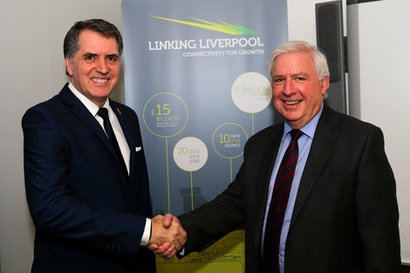
Liverpool City Region Metro Mayor, Steve Rotheram, has shared his vision for the future of the region, with ten big pledges that include a project to harness the power of the River Mersey, spearheaded by highly respected industry leader Brent Cheshire, who was until recently UK Chair of Dong Energy.
Cheshire’s initial task over the next 12 months will be to establish the core business case for the multi-billion renewable energy project.
“I am delighted that Brent has agreed to lead this project” said Steve Rotheram. “It has been debated and discussed for over three decades. Devolution finally gives us the opportunity to deliver a project of this scale, and Brent provides us with the expertise, experience and leadership capability to turn vision into reality.”
Brent Cheshire added that he is pleased to accept the invitation to head the Special Purpose Vehicle that will take the project forward and that it is a hugely exciting and ambitious vision with the potential to impact massively on the City Region’s long-term economic prospects.
“Liverpool City Region has delivered world-changing engineering projects in the past, so if it can be done anywhere it can be done here” Mr Cheshire said.
The River Mersey has a mean tidal range of 6.5 metres and a potential basion of 61 square kilometres. It has significant potential as a tidal energy resource while it’s exposed coastline is already providing valuable wind resources, with Seaforth Wind Farm on the Royal Seaforth Docks operating since 1999. The initial timetable for the tidal energy project envisioned commissioning of the scheme by 2020.
Peel Energy, in partnership with the North West Regional Development Agency (NWDA), set out to explore the potential benefits and impacts and the scheme was supported by the Mersey Basin Campaign. A consortium led by consultants Buro Happold was commissioned in July 2006 to undertake a ‘pre-feasibility’ Phase 1 Study. This identified a number of viable schemes and a feasibility study was commissioned in September 2009. This was completed in July 2011.
The feasibility study found that a tidal power scheme in the Mersey Estuary could deliver enough electricity to meet the needs of over 200,000 homes. Unfortunately, it also found that the high construction costs meant that, at the time, the project was unlikely to go ahead.
The preferred scheme in 2011, identified by the feasibility study commissioned by Peel Energy and the NWDA, was to utilise a barrage across the river between New Ferry (Wirral) and Dingle (Liverpool). This would be designed in such a way that the turbines within the barrage would generate power from the ebb tides and the flood tides and from a range of water level differences (operating heads) across the barrage. This would enable a range of operations that would also minimise effects on the River Mersey’s intertidal habitats.
Given the costs of construction, Peel Energy withdrew from the scheme in June 2011, but in June this year Metro Mayor Rotheram announced that he would seek to revive the scheme. He also announced that he would appoint a project director to bring the scheme back on line, with a view to making Liverpool City Region carbon-neutral by 2040.
The project has been debated for over three decades, but Rotheram now feels that devolution has given Liverpool City the opportunity to revive the scheme and finally get the project built.
Image: Metro Mayor Steve Rotheram (Left), Mr Brent Cheshire (Right)
For additional information:
Mersey Tidal Power (for information on the previous tidal barrage plan)

